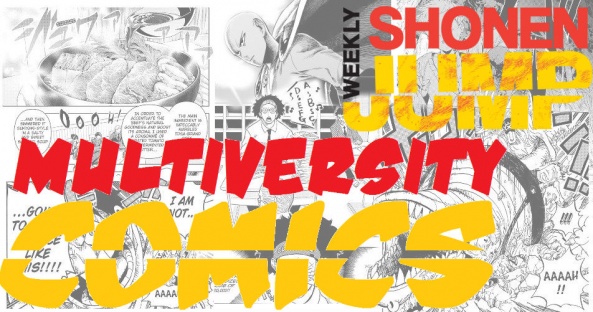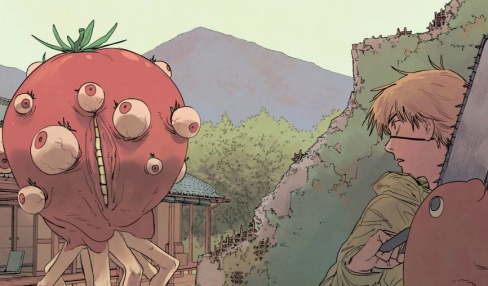
Welcome to This Week in Shonen Jump, in which a rotating duo of Multiversity staffers take a look at two stories contained in each installment of Viz Media’s Weekly Shonen Jump. For the uninitiated, Weekly Shonen Jump is an anthology that delivers more than 200 pages of manga of all varieties. We hope that you’ll join us in exploring the world of Weekly Shonen Jump each week. If you are unfamiliar, you can read sample chapters and subscribe at Viz.com.

This week, Rowan and Matt check in with “Chainsaw Man” and “The Promised Neverland.” If you have any thoughts on these titles, or “My Hero Academia,” “Dr. Stone,” “Black Clover,” “One Piece,” “Food Wars,” or “We Never Learn” let us know in the comments!

Chainsaw Man Chapter 1
Written and illustrated by Tatsuki Fujimoto
Reviewed by Rowan Grover
Big SPOILERS in this review!
The manga industry has seen some truly bizarre concepts and stories in its time, and “Chainsaw Man”, to possibly no-one’s surprise, tends to exist on this spectrum. Relative newcomer Tatsuki Fujimoto starts us off here with a relatively simple premise of the protagonist Denji trying to pay back the debt that his father’s untimely death left him with. Cleverly, Fujimoto seems to have already set us up with the ongoing premise: Denji is a ‘Man’ who wields a ‘Chainsaw’… that is also his pet. Following in the footsteps of manga like “Devilman” before it, Fujimoto proceeds to dial things up to eleven, [SPOILERS] having Denji dismembered by the Yakuza before his Chainsaw pet decides to bond with his body, granting Denji supernatural Chainsaw-based abilities. It’s a complete sidewinder that comes out of nowhere and makes the story immediately engaging as the reader is unsure of what to expect next.
Underneath this high-concept story, Fujimoto has written a truly sympathetic and endearing protagonist. Denji is introduced as the Sisyphean protagonist – he’ll complete one job as a devil hunter to chip away at his debt, before realizing the expenses the hunt has cost him has left him not much further from where he started. Regardless of that, we see that Denji has a close relationship with his Chainsaw pet Pochita, which makes him instantly relatable and gives readers more reason to care for him as we see he’s not just trying to look after himself. To see this mellow and pitiable protagonist shift to hyper-violent and maniacal in the final act of the issue is superbly contrasted, as it’s as if the parts of Denji that he’s fought to suppress have finally been released in a blaze of emotional glory. Fujimoto ensures that we care for our protagonist, but shows us that he’s not entirely pathetic either.
The character artwork here, particularly on Denji, is dynamic and interesting. Fujimoto paints his body language and tired facial expressions of someone who’s something of a slacker, and we definitely get a more laid back sense from Denji because of this. He’s had a lot of hard times brought down upon him, but he seems to brush them to the side with a tired smile, making the emotional snap at the end of the issue make even more sense. We see this tired side of Denji best in the quieter moments, particularly when he’s alone with Pochita lamenting the dangerous aspect of his chosen career path. I love how sudden the shift to madness is, however, as Fujimoto still shows the resurrected Denji as dream-like and airy, before he finally breaks down and pulls his chainsaw ripcord. It’s a dynamic visual and emotional change that gives readers a sense that the pacing is skyrocketing from this point forth.
Fujimoto has a style here that ranges from clean-lined and elegant to super detailed and gore-filled. This change progresses as the themes and story changes, a nice visual change to make it easier for readers to process the sudden story shifts. This shift happens most clearly when Denji is stabbed by the Yakuza, and we start to see the background grow more chaotic as Denji himself starts to fizzle into more loosely constructed linework. Fujimoto plays with claustrophobic scenes well here, as we start to lose sight of Denji as piles and piles of Yakuza zombie bodies fall onto him. The environments start to get more chaotic as all we see is a pile of flesh before clarity breaks through with Denji’s chainsaws shredding through the masses. It’s symbolic visual storytelling at its most bizarre and action-packed.
Continued below“Chainsaw Man” is a tour de force of dynamic art, dramatic pacing and high-concept fiction. Fujimoto develops a protagonist that is both sympathetic and terrifying, whilst hitting us with unexpected plot twists at every moment. It’s a debut that will be remembered for some time to come.
Final Score: 9.0 – A high-octane, seething debut, “Chainsaw Man” is as bizarre as its name suggests, and then a whole heap more.

The Promised Neverland Chapter 114
Written by Kaiu Shirai
Illustrated by Posuka Demizu
Reviewed by Matt Lune
“The Promised Neverland” has had a crazy few chapters. The kids (mostly) survived the threat of the Ratri clan but lost Lucas and Yugo when their old hideout exploded. They faced down the sole surviving enemy of that explosion only to see him eaten in a gloriously grotesque double page spread. We also got a heartbreaking send-off for Yugo, who’s saved their lives more than once and found the family he lost so many years ago. This latest chapter attempts to slow things down a bit, and as such serves as a sort of palette cleanser between courses. It’s fine, you’re just gearing up for the next big thing.
In the last chapter, we were introduced to the man who calls himself William Minerva, and the four demon slayers that follow his orders. The hope is that we’ll touch in on them again, and soon because they were a refreshing change, which is itself surprising for a series that’s constantly on the move. Getting to see Minerva and his gang was like finally seeing the back half of the plane in Lost, you knew they were out there, and finally, you were getting to see people outside of the bubble of characters you’re used to. As such, this chapter suffers from following that introduction, as it really feels like we should have spent more time with them than seeing the kids travel for 10 days with mostly nothing happen to them.
It’s good to see the characters rest and recover from the ordeal they’ve just been through, and to its credit, the chapter speeds through the 10-day travel by the end of this week’s page count. You have to imagine that more exciting things are going on with Minerva though, and after being teased with that introduction last week, it left you wanting to know more about the characters.
With the cast out in the forest again, artist Posuka Demizu uses the threat of death to introduce the claustrophobia that this series is great at. Almost every panel is either intersected with imposing tree trunks or else enclosed by a surrounding darkness. The density of panels on the page also feels like it increases, which helps convey that feeling of being a small group trapped in a forest of dangers.
Overall, this is a necessary chapter of “The Promised Neverland,” but only because it contrasts against the action of previous chapters. The final few pages drop us right back into the drama again, showing that there’s never much time to rest for the escapees of Goldy Pond, but as a stand-alone slice of the greater whole, chapter 114 is pretty forgettable.
Final Verdict: 6.9 – A necessary moment of calm before the next big drama, but otherwise fairly skippable.






